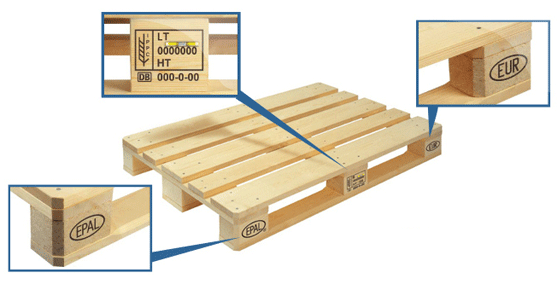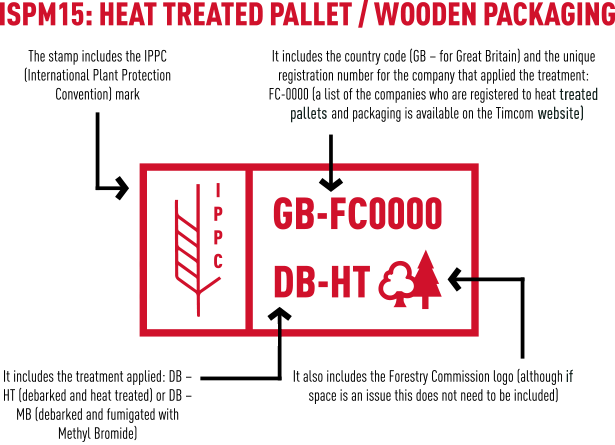ISPM 15 Regulations.
ISPM-15 Regulations For Wooden Packaging.
Globalization and increased international trade flow have led to non-autochthonous animal and plant materials being distributed around the world. The organisms in wood can be parasitic, that can lead to diseases in plants and plant products. With the use of the ISPM-15 regulations one tries to prevent the spread of non-autochtonous parasites.
The Food and Agriculture Organization (FAO).
The Food and Agriculture Organization (FAO) is the originator of ISPM-15 and a specialized agency of the United Nations that leads international efforts to defeat hunger. Our goal is to achieve food security for all and make sure that people have regular access to enough high-quality food to lead active, healthy lives. With over 194 member states, FAO works in over 130 countries worldwide. We believe that everyone can play a part in ending hunger.
Heat Treatment.
First (expansive) choice in protection.
Since 2015 is heat treatment (HT) the only treatment that can be used for common application. Wood packaging material must be heated in accordance with a specific time–temperature schedule that achieves a minimum temperature of 56 °C for a minimum duration of 30 continuous minutes throughout the entire profile of the wood (including at its core). Various energy sources or processes may be suitable to achieve these parameters. For example, kiln-drying, heat-enabled chemical pressure impregnation, microwave or other treatments may all be considered heat treatments provided that they meet the heat treatment parameters specified in this standard.
Insect treats:
• anobiidae
• bostrichidae
• buprestidae
• cerambycidae
• curculionidae
• isoptera
• lyctidae
• oedemeridae
• scolytidae
• siricidae
• bursaphelenchus
• xylophilus
Exemptions.
Presswood Pallets.
• Sawdust, wood shavings, recycled wood and wood wool.
Plastic Pallets.
• Plastic Mondipal pallets are fully free of any ISPM-15 laws and regulations.
6 mm Wood Packaging.
• Wood packaging material made entirely from thin wood (6 mm or less in thickness).
Wood packaging.
• Wood packaging made wholly of processed wood material.
Euroblock Palletblocks.
• Wood fiber export palletblocks 100% ISPM-15 proof.
Barrels.
• Barrels for wine and spirit that have been heated during manufacture.
Sawdust.
• Sawdust, wood shavings and wood wool.
Gift Boxes.
• Wood components permanently attached to freight vehicles and containers.
ISPM 15 revision(2009).
The Revision of ISPM No. 15 (2009) under Annex 1,[2] requires that wood used to manufacture ISPM 15 compliant Wood Packaging must be made from debarked wood[3] not to be confused with bark free wood. ISPM 15 was updated to adopt the bark restriction regulations proposed by the European Union in 2009. Australia held out for approximately one year with more stringent bark restrictions before conforming July 1, 2010 [4].
Debarked wood packaging.
Wood packaging materials must be debarked prior to being heat treated or fumigated to meet ISPM 15 regulations. The debarking component of the regulation is to prevent the re-infestation of insects while lumber is sitting to be manufactured, or even after it has been manufactured. The official definition for debarked lumber according to the ISPM 15 Revision (2009) is:
"Irrespective of the type of treatment applied, wood packaging material must be made of debarked wood. For this standard, any number of visually separate and clearly distinct small pieces of bark may remain if they are: - less than 3 cm in width (regardless of the length) or - greater than 3 cm in width, with the total surface area of an individual piece of bark less than 50 square cm."
Argument for bark removal.
What are the post-treatment levels of infestation (with and without bark) compared with pre-treatment levels? Overall, from the studies presented there is either: a) no significant difference between infestation levels of treated and untreated wood; or b) differences identified are related to the species of insect which may prefer treated or untreated wood.
Internationally accepted types of treatment.
• HT (Heat Treatment) - The wood needs to be heated until its core reaches 56 °C for at least 30 minutes.
• Steady Heat Treatment (HT): Standard procedure conducted in heating chambers;
• Kiln-dried (KD): Similar to the standard HT, but it also requires moisture's standards;
• Mobile Heat Treatment (HT): Heat treatment conducted in heating chambers installed in trucks. Allows the treatment to be done anywhere.
• Portable Chamber Process (PCP - HT): Heat treatment conducted in portable chambers made of thermal fabric. Allows the treatment to be done anywhere, but with lower costs. The process' patent requirement belongs to the Brazilian company Fitolog Pest Control;
• Fast Container Connector (FCC - HT): Heat treatment conducted directly in containers by a mobile heating unit. It is a simplified variation of PCP. Ideal for ports and terminals.
• MB (Methyl Bromide) - Requires to completely fill an area with gaseous pesticide (methyl bromide).
• Container Fumigation: The container where the wooden packaging is placed is completely filled with Methyl Bromide. After a 24-hour quarantine, the container is aerated and the wood/cargo is released;
• Tent Fumigation: The wooden packaging is covered with a specific type of tent, sealed to the ground with weight. The tent is completely filled with methyl bromide. After a 24-hour quarantine, the tent is removed and the wood/cargo is released.
Countries participating in ISPM 15.
Although this is only a reference, confirmation with the export authority when exporting to another country is required. This is a complete list as of July 1, 2010.
Countries and their approximate ISPM 15 Adoption Date.
• Algeria April 2017
• Argentina: June 2006
• Australia: Sept 2004; Complete Adoption: July 2010
• Bolivia: July 2005
• Brazil: June 2005
• Bulgaria: Jan 2006
• Canada: Sept 2005 (US-Canada exemption)
• Chile: June 2005
• China: Jan 2006
• Colombia: Sept 2005
• Costa Rica: Mar 2006
• Cuba: Oct 2008
• Dominican Republic: July 2006
• Ecuador: Sept 2005
• Egypt: Oct 2005
• European Union: Mar 2005
• Austria
• Belgium
• Bulgaria
• Croatia
• Cyprus
• Czech Republic
• Denmark
• Estonia
• Finland
• France
• Germany
• Greece
• Hungary
• Ireland
• Italy
• Latvia
• Lithuania
• Luxembourg
• Malta
• Netherlands
• Poland
• Portugal
• Romania
• Slovakia
• Slovenia
• Spain
• Sweden
• United Kingdom.
• Guatemala: Sept 2005
• Honduras: Feb 2006
• India: Nov 2004
• Indonesia: Sept 2009
• Israel: June 2009
• Jamaica: January 2011
• Japan: Apr 2007
• Jordan: Nov 2005
• Kenya: Jan 2006
• Lebanon: Mar 2006
• Malaysia: Jan 2010
• Mexico: Sept 2005
• New Zealand: April 2003
• Nicaragua: Feb 2006
• Nigeria: Sept 2004
• Norway: July 2008
• Oman: Dec 2006
• Paraguay: June 2005
• Peru: Mar 2005
• Philippines: June 2005
• Saudi Arabia: February 2009
• Serbia: June 2005
• Seychelles: Mar 2006
• South Africa: Jan 2005
• South Korea: June 2005
• Sri Lanka: Mar 2004
• Switzerland: Mar 2005
• Syria: April 2006
• Thailand: February 2010
• Taiwan: Jan 2009
• Ethiopia 2006
• Trinidad & Tobago: July 2010
• Turkey: Jan 2006
• United States: Sep 2005
• Ukraine: Oct 2005
• Venezuela: June 2005
• Vietnam: June 2005
Reference Web Links For ISPM 15:
https://en.wikipedia.org/wiki/ISPM_15



